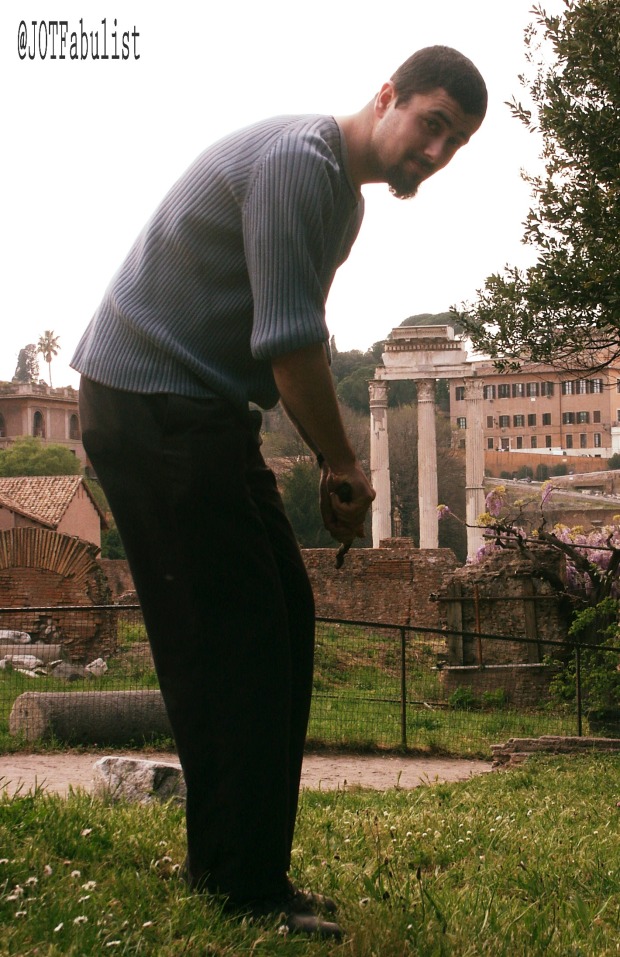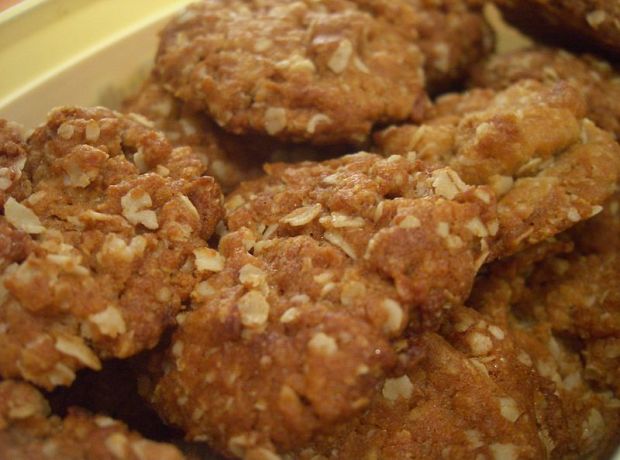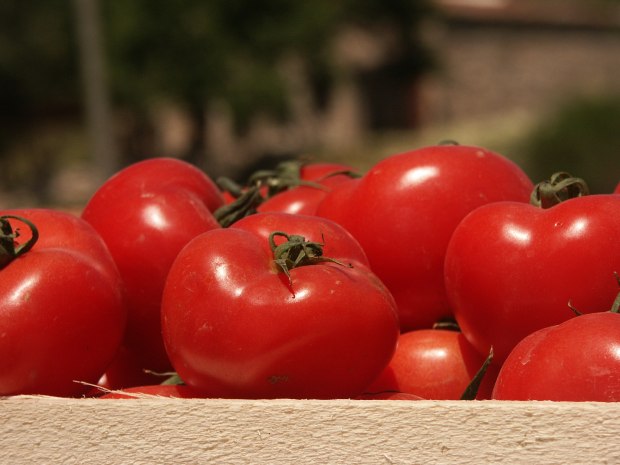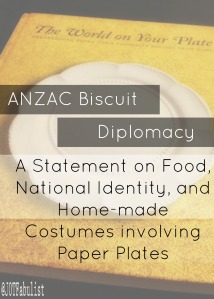ANZAC Biscuit Diplomacy: a statement on food, national identity, and home-made costumes involving paper plates
| from: | Æ | ||
| to: | Bronwyn |
||
| date: | 21 July 2014 08:49 | ||
| subject: | So apparently |
“We have two children going to school now and both of them are expected to be racially harmonious. Don’t forget to get the cricket bat when you pick up T.”
Every time the school has a Racial Harmony Day we spend too much time cringing over all the earnestness and too little time constructing home-made Sydney Opera House costumes from paper plates.
H, if you’re reading, you’re an inspiration and also a lesson. If we’d got on the paper plate bandwagon we may not have had to console our daughter today on account of “not being Chinese”, which (I can’t quite untangle this) has something to do with flags, seaweed, and pretty dresses.
Her father, at the last minute, threw her into a yellow T-shirt and navy (close enough) culottes and handed her a cricket bat. Great Australian tradition, he said. You can just picture them playing it in the Dreamtime.

Although the sport is obviously not exclusive to Australia. Here, we find evidence of its existence in Ancient Rome.
As for me – I was on catering, but rather than whip up an enticing batch of lamingtons (H, be my mentor) I frittered my time on a philosophical debate with an absent ambassador over the diplomatic nuances of food.
My reference book was The World On Your Plate – collaboratively written by various ambassadors to Singapore as part of a fundraising effort for the Tang Tok Seng hospital. What dish, I wondered upon receiving it, had the Australian High Commissioner brought to the same table as the Filipino Adobo or the Laotian Laap? Could it compete with the historical richness of the Spanish Paella? Could it embody as much festiveness as the Chinese Jiao Zi?
ANZAC biscuits. That’s what he brought. So… yes. And also… huh.

And, granted, yum. Source: pfctdayelise via Wikimedia Commons
Not that there’s anything wrong with that
I’ll be the first to stand proudly (by which I don’t mean “to attention”, but “at a carefully-calculated ease from which one can shoot a rabbit or reveal an oversized knife with a fluidity of movement which defies expectation”) and say there’s a strong argument for the ANZAC biscuit, not least of which is that it’s a darn tasty biscuit.
But it also embodies many of the fine qualities we like to think of as being part of the Australian National Character.
It hints at resourcefulness – being the far greater sum of the basic ingredients which constitute its parts; practicality – being so full of golden syrup they won’t spoil under pretty much any storage conditions over pretty much any period of time; and tenacity – whether you subscribe to the school of make-em-so-they-won’t-break-even-if-you-fold-em-in-half, or the school of make-em-so-they-won’t-break-even-if-you-bang-em-with-a-mallet.
Nor do I want to spit on the biscuit’s origins: the war that forged not only our nation, but a very fine movie starring Mel Gibson and a tradition of pilgrimage to Gallipoli in which I, myself, have partaken, and during which we really did watch that Mel Gibson movie. Far be it.
The ANZAC biscuit, in sum, is a great biscuit indeed, and one that any Australian should dutifully shovel into the mouths of the coming generation until they learn a fond affection for it, borne either of genuine taste and sweet memories, or (failing that) of a kind of oat-based Stockholm syndrome. It is just that important.
Still. I wonder if it’s the right message for today.
Modern Australian
Modern Australian cuisine is something I recognise when I taste, but can’t accurately explain. It’s what SBS Food describes as an unashamed mix of inspiration from South-East Asia, the Mediterranean, Europe, and just, like, wherever.
It’s the sort of thing that happens when you take bread and butter pudding, and add chai spice, or decide to put Thai curry paste in your sweet potato soup.
It’s vibrant. It’s multicultural. It’s fresh and boldly-flavoured and maybe just a teensy bit disconcerting. What it isn’t is the very same mixture of oats and syrup your Grandfather grew to love in the trenches of Europe, fighting a war at the behest of Mother England.
So it’s tricky.
WWCD (What Would Camilla Do)?
I asked recently-repatriated chef, Camilla Baker, what she’d do, and she said salads and grills. A sort-of tabouleh, perhaps, but with generous quantities of cous cous rather than bulgur, coriander instead of parsley and mint, and shreds of BBQ chicken mixed through – plus some chopped lettuce.
Or go for a noodle salad, with honey soy chicken wings and snow peas. Bonus points for including fresh ginger. Satay’s another option, with an English garden salad on the side.
More Paul Hogan than Mel Gibson, in other words.
In the end, we went for the sort-of tabouleh plus a watermelon and banana fruit salad with yoghurt, and sent the kids along with cricket bats and “footballs”. We totally should have gone for a paper-plate opera house – mistakes were made – and I don’t think ANZAC biscuits should be absolutely off the list.
But if I was Ambassador, I’m not sure I’d introduce my whole country in a cookbook with one. I preferred our culinary statement instead.
Related:
The best darn recipe site for Modern Australian Cuisine on the internet.
How to make ANZAC biscuits (at least according to some people).
Cheers once again to a great chef now in Sydney – Camilla Baker.
The contents of The World On Your Plate so you can see what your ambassador did for you, if anything.
The post Anzac Biscuit Diplomacy appeared first at Journeys of the Fabulist and was shared as part of the Creative Kids Blog Hop #18.


























I think the Anzac biscuits were a great choice, no matter how they turned out. You lost me at the cork hats though. I think Hawaii has claimed the macadamia nut know, so we are left with the lamington and maybe sarsparilla softdrink!!! Great post.
LikeLike
Hawaii has what? Never. You can’t call something The Queensland Nut then say it’s from Hawaii. (At least sarsaparilla is safe – I think you have to be brought up on it 🙂 )
LikeLike
That is very true. Sars is an acquired taste but I like it especially with. fish and chips at the beach
LikeLike
Ooh. Now you’re talking.
LikeLike
I won a contest run by an Aussie blogger about a year ago, and part of my goodie-filled-basket included Tim Tams. Holy mother of all things good… those things are AMAZING! So the ANZAC has some mighty big shoes to fill…
LikeLike
A lot of people like Tim Tams and a lot of people like ANZAC biscuits, but usually not for the same reasons. A warning! 🙂
LikeLike
Hmm. Now I’m even more intrigued.
LikeLike
Try the recipe linked at the bottom! You’ll get the general idea (even if your cooking is as messed up as mine is – which it’s almost certainly not).
LikeLike
Hey, that does look pretty easy. There’s s possibility I won’t mess it up. 🙂
LikeLike
I have never been to Australia so I have no idea what ANZAC biscuits taste like. Filipino Adobo on the other hand was lunch yesterday. 😀
LikeLike
Knowing your cooking skills, as evidenced by your blog, they’d be a snap for you to try. So there’s a blog challenge for you straight away – recipe linked in the post!
Good to hear your ambassador got it right! Our family loves adobo – it’s a crowd pleaser.
LikeLike
I have never tried Anzac biscuits. Where can I get them? I know when I go to Australia, I buy nougats and macadamia nuts. These are almost trademark souvenirs from your country. Ah… and may I mention something not so related to culture? I love Sportsgirl if that rings a bell :p
LikeLike
Not sure where to get them in Singapore. You could always try following the recipe at home 🙂
Sportsgirl! Oh, you take me back!
LikeLike
Love Sportsgirl!
LikeLike
🙂
LikeLike
Maybe you should have narrowed it down to a ‘state thing’.
T was born in Queensland and when I think of Queensland food I think – tropical fruit salad with lots of bananas, pineapples, mangos and the like. Then there’s a pavalova decorated with tropical fruits although New Zealanders of course would argue that the pavalova was their invention but we all know they are wrong.
Oh – and don’t forget the macadamia nuts too – although not with the fruit salad or the pav.
As for the national dress – maybe jeans and a flannie topped with a crown adorned with corks for keeping the flies away……
LikeLike
We were halfway there on the fruit salad then. I thought of macadamia nuts but I don’t think Queensland schools allow them any more so that would have lacked something in authenticity.
The cork hat thing though – it’s a bit ANZAC biscuit. Same dilemma, different form.
LikeLike
Learned something new: modern australian cuisine sounds wonderful. Quite like that “disconcerting”. So how’d the biscuits go over? Can’t go wrong with all that syrup.
LikeLike
We went for the more modern version. It has everything to do with politics and nothing at all to do with the fact that my ANZAC biscuits have always turned out horribly.
LikeLike
I don’t even like ANZAC biscuits. For me, Australian food is all about variety of different foods and cuisines so impossible to encapsulate in one dish. When I am overseas, I miss all the variety. I miss having the best butter chicken I have ever had, awesome noodles, sushi, chinese dumplings, yummy saganaki, Vietnames rice paper rolls, Ethiopian feasts, delicious Australian styled breakfasts and awesome pizza within a 15 minute walk from my home. It’s all this and more that I think of when I think of “Australian” food.
LikeLiked by 1 person
(You don’t like ANZAC biscuits???)
But yes, the variety. All those examples made my mouth water. I do appreciate how hard a job it must have been to narrow it down to one dish, under the circumstances.
LikeLike
Sorry but they are yucky 😉 I think some vegemite toast would have been better!! Or tim tams.
LikeLike
Well no argument on the tim tams. I’m relieved to hear you’ll eat vegemite on toast. 🙂
LikeLike
Ha, I’d describe Australian food as “normal but a lot tastier” 😉 Your food really has benefitted from all the nationallities bringing their best bits and adding it to the cuisine! But Anzac buiscuits were not a bad choice!
LikeLike
It’s so tough to narrow it down to one dish. But yes – best bits combined. That’s definitely the aim!
LikeLike
“oat-based Stockholm syndrome” What a wonderful description for being force-fed until you like it. 🙂 Take no prisoners. And for the record, Australia needs to send the world more actors and actresses. I think I like them all. –Curt
LikeLike
I will write to the appropriate association: “Please send more actors stop.”
LikeLike
Thanks. 🙂
LikeLiked by 1 person
You know, I still have never had an ANZAC biscuit, though it’s on my to-do list: to make a batch so I can try them. Another blogger gave me a recipe.
LikeLike
They would be so easy for you. (I presume you can source golden syrup from somewhere..)
LikeLike
For the record, P did not take an Aussie Rules football – he had a rugby ball. Which made sense as he was clearly dressed as a rugby player. We don’t actually own one of those funny red balls for the adjectivally national football. Honestly, I don’t know how you pass the mandatory sports quiz at Australian immigration some days …
LikeLike
I just throw them a carefully-calculated pose from which one can shoot a rabbit or reveal an oversized knife with a fluency of movement which defies expectation and they wave me on through.
Luckily there are no rabbits at the airport, and security won’t allow knives, because otherwise the game would be up.
LikeLike
New York Cheesecake!!?? Oh my, that is hilarious, I know more Americans that dislike cheesecake than like it. I will have to check out these biscuits… they look like oatmeal cookies to me. I am so glad you were in touch with Camilla! I miss her posts.
LikeLike
Yes, me too! When she gets settled she might start blogging again…??
Interesting to hear your take on the cheesecake – I guess each culinary tradition has its controversies then!
(Seriously, though – how can anybody not like NY cheesecake?? You like it, don’t you?)
LikeLike
Of course! If it was lower in calories and more healthy I would eat it for every meal!
LikeLike
Phew! Well that’s a relief. I was a bit worried there for a moment. 🙂
LikeLike
I am glad I could assuage you! Haha… I think I need to go get some cheesecake now… Oh wait, I’m in Thailand, no cheesecake for me 🙂
LikeLike
Seriously – none in Thailand? A dish like that should go global. You’ll definitely have to make it down to Singapore again (can’t promise it’ll be just like NY but I will certainly not complain).
LikeLike
Well some places have it, but it is a shallow representation of the real thing usually. Actually my friend makes it occasionally and it is wonderful. I am glad that she only makes it occasionally though, I would have to get two seats on my next flight otherwise!
LikeLike
Ha. Yes. Although the jogging would cut into that…
Ok, now I’m reluctant to recommend anywhere in Singapore. Some versions I’ve had even I can tell they’re a bit light, but overall I’m not that confident in my cheesecake palate. Plus I can’t remember where the good/not-so-good stuff is.
LikeLike
This is the problem with expat life, we start to think what we have actually tastes like the ones back home. haha
LikeLike
I know exactly what you mean. Exactly what you mean.
LikeLike
Buahahaha crying over not being Chinese, I don’t know why that is so funny to me. And THIS is my go-to state at all readiness: “a carefully-calculated ease from which one can shoot a rabbit or reveal an oversized knife with a fluency of movement which defies expectation.”
LikeLike
I am so good with that move right up until the “fluency of movement” part. Then it all just goes to pot.
LikeLike
Well there’s always some inspiration, humour, tour and philosophy on this page. Racial harmony and the Anzac biscuit. Hmm! It has a nice ring to it doesn’t it? You’ve inspired me to go find another Australian icon to satisfy the hunger generated by your Anzac biscuit blog. Time for a chocolate. 🙂
LikeLike
I wish all diplomacy was edible. (Gives a new meaning to eating your words?)
Actually, let me amend that. I wish all diplomacy was chocolate. Now you’ve got me craving a Tim Tam.
LikeLike
ANZAC biscuits are a new one for me. Got me thinking what Canadian food might be. How about a jug of maple syrup and call it good?
LikeLike
Maple syrup, preferably with pancakes and bacon. Not sure how Canadian you think that is, but it’s pretty tasty so definitely a dish to be proud of from my angle.
LikeLike
During the Calgary Stampede there are free pancake breakfasts all over the city so that must give pancakes and bacon some Canadiana stamp don’t you think?
LikeLike
I… yes, I think you’re probably right but could you just excuse me for a moment while I google “Calgary Stampede”?
LikeLike
Oh, that’s the rodeo! Right. Yes. Yes, you are right.
LikeLike
(Although if you want to vote for meal worm pizza then I don’t judge.)
LikeLike
I don’t think meal worm pizza will have a Canadian feel. I think meal worms, like scorpions are imports. 🙂
LikeLike
But is the combination of meal worms AND pizza Canadian? (Because as you can see following the definition of Modern Australian Cuisine that absolutely makes it count.)
LikeLike
No I don’t think you could get a single Canadian to put a maple leaf on that one. 🙂
LikeLike
Haha. I wouldn’t own up to it, either. Well, secretly, perhaps, in a sort of perverse way. I mean, meal worm pizza.
Just found your link for those following along at home:
http://traveltalesoflife.com/2014/07/11/chocolate-dipped-bacon-and-scorpion-pizza-eating-at-the-calgary-stampede-a-wild-ride/
LikeLike
Thanks Bronwyn. Yes might make more sense to have the post as reference or possibly have all your readers come to the Calgary Stampede. One or the other. 🙂
LikeLike
Well obviously the “other” is preferable, but options for practicality’s sake. 🙂
LikeLike
Hey! I’ve nominated you for the ‘Versatile Blogger Award’! Go here to find out more! (sorry if you’ve already been nominated!)
https://worldjourneysdiscover.wordpress.com/2014/07/23/versatile-blogger-award-nomination/
LikeLike
Thanks! Honoured to have been nominated 🙂
LikeLike
I think the Opera House hat has the look of a Roman soldier to it. The Aussie Princess look is hard to visualize, so I can see why Chinese has more appeal for T!
LikeLike
True. Very true.
But yes, Aussie princess… I guess you’d have to dress up as Kylie Minogue, Pop Princess, and even then the look is a bit vague.
LikeLiked by 1 person
This sounds a lot like the World Community Day at our school only we get to represent countries where we DON’T live. The year I pulled Australia I was paired with an overachiever who wrote away to the tourist board and tracked down a didgeridoo, but the year I had Egypt I was paired with another mom like me who showed up barely prepared and we winged an activity involving hieroglyphic stamps.
LikeLike
Hieroglyphic stamps – best activity ever! Have you ever tried to play a didgeridoo? (Wait – yes, I imagine, courtesy of the other parent.)
I’m wondering if it would take the pressure off to represent foreign countries (you can always plead ignorance) or if it would add to it (but you might still offend everyone).
LikeLike
Fortunately, it’s hard to insult people who don’t know any more than you do.
LikeLiked by 1 person
LANCASHIRE hotpot with YORKSHIRE pudding??! Are they trying to incite another War of the Roses?!?!
LikeLiked by 2 people
I’ll look forward to your full analysis of the situation (complete with personally-chosen alternative) on your blog. 🙂
LikeLike
Ha! I love ANZAC biscuits (in their place – lunch boxes and other casual morning tea capers) but as a contribution to a nation’s cookbook? Nay 🙂 As to what, though, I’m not sure – I think Modern Australian is more a description rather than an actual cuisine, and certainly doesn’t offer any guidelines.
LikeLike
It’s probably not mature as a cooking genre. Definitely in “know it when I taste it” territory. I do appreciate the difficulty of the task.
Lunch boxes – excellent place for ANZAC biscuits. Nothing better for a lunch box.
LikeLike
I love ANZAC eating and baking bikkies, though commit the cardinal sin (according to some) of adding sultanas.
Interesting thoughts though.
LikeLike
I… I’m not sure I can even reply to this comment after the whole “sultana” thing.
I couldn’t entirely fault the choice, it’s true. But I was kind of disappointed in the choice as a single dish to represent us. It’s tough to come up with an alternative, though.
LikeLike
Why weren’t those famous Queensland cinnamon donuts considered? And isn’t a Steve Irwin bush outfit suitable? (As we’ve discussed previously: “national days” are the worst!)
LikeLike
I was thinking of you and the cowboy costume with this one. P wanted to go as an astronaut, by the way, but we don’t have a space program.
LikeLike
Darn … The tin foil astronaut would have been easy.
LikeLike
And you know that’s just the six-year-old (and parents-of) version of that complaint. You should hear what the rocket scientists have to say about it.
LikeLike
Hmmm, ANZAC biscuits are new to me too. What does the Sydney Opera House have to do with diversity? (Whether the real one or a paper plate one)
All kinds of mysteries in this post for me.
LikeLike
It’s about as close to a “National Costume” as we come.
It’s definitely a head-scratcher, that one. Out of interest, what would you say the Australian National Costume is?
LikeLike
I wasn’t aware there was such a thing as a national costume – Australian or otherwise. I feel it falls into the same category as a national doorknob or a national bolt (as in an attaching device) or perhaps a national screw (get your mind out of the gutter Bronwyn). I would have to say that from eastern Canada, the first image that pops to mind when someone says Australia, is a kangaroo (after Journeys of the Fabulist, of course).
LikeLike
Some countries seem to have, if not national costumes, then at least a recognisable traditional dress. There was a little girl there in Korean dress, for example. (That might have been one of the costumes that made T cry with envy.)
Australia – not so much. Jen of Expat Lingo had the same problem with an American “national costume”:
http://expatlingo.com/2014/05/23/young-americans/
LikeLike
Mmm, ANZAC biscuits! I remember those! I guess Tim Tams would have been an alternative choice… 😉
LikeLike
Tim Tams are always popular, but not as home-makeable. (Also, the school requested we didn’t just go out and buy a packet of chocolate biscuits. Something about health, etc etc. Don’t they know eating junk food is part of our National Identity?
LikeLike
They’re probably trying to keep that on the down-low 😉
LikeLike
We’re not. Why should they? 🙂
LikeLike
How can I have never heard of the anzac biscuit as a citizen of this global food court we all sample from?!
LikeLike
You must track some down and/or cook some immediately, just for the cultural experience.
LikeLike